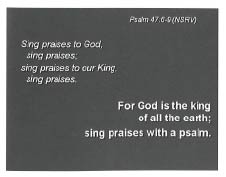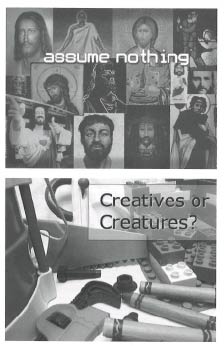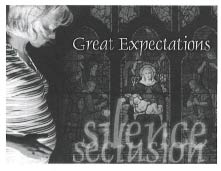Updated April, 2025
Given expensive equipment and potential conflicts over changes in worship style, the purchase of a video projector system is often a difficult decision for churches to make. But it’s only a first step. Once installed, the Sundays keep coming and the question becomes, What next? What do we put on the screen, week after week? How can we use the screen to do more than reproduce the texts from the bulletin and songbook? How can the screen lead the congregation in its liturgical tasks rather than call attention to itself? And who will produce this imagery? What talents must be brought together? How much can reasonably be accomplished regularly?
Simple Text

One simple way for the screen to help lead in liturgy is to vary the color, style, and position of simple text according to who is speaking. If worship is a dialogue between God and his people, we can accentuate the exchange by having God’s words appear differently from the congregation’s words. The Call to Worship, for instance, being God’s call to us to be gathered in his name, might appear in the upper left with white text. The song of praise that often follows is our joyful response to his invitation. That response might appear right-justified in the lower corner, using yellow text. It’s a subtle difference, but one that reinforces the very structure of worship and guides the congregation’s role in it. Other aspects—color, font, simple shapes—could be used to walk the congregation through liturgy as well. The limitation of plain text, however, is that it does not use the full visual potential of the screen.
Thematic Metaphor

A more ambitious option would be to create graphics for each week that fit the theme for each service. Maybe the theme is as broad as the liturgical calendar, using images of fire at Pentecost, or as pop-culture specific as using images from the Lord of the Rings movies as a study in faithfulness. These weekly graphics attempt to capture the theme or thesis of the service in some visual way, maybe providing a visual metaphor for the day’s key lesson. The main challenge with a weekly theme, however, is the intensive resources required to produce custom graphics each week. Someone has to conceive, design, photograph or draw, and produce a thematically poignant image. It requires not only expertise, but significant time, week after week. It’s also limited in a liturgical sense. While stating the general theme of a whole service, a single image doesn’t help the congregation walk through their tasks in worship. It might teach a lesson or set a tone, but it doesn’t lead beyond that. When do you show a thematic metaphor? At the beginning? During the sermon? Throughout the service?
A Visual Instrument
Both of the above approaches are useful and worthy but limited. If we were talking about worship music, it would seem strange to have just one tune that sets the tone for the whole service. Would it be a prelude? Prayer song? Doxology? Would a single tune serve for all three, the same song repeated over and over throughout the service? Or in the case of plain text, it would seem a waste to have a multi-register organ that was used to play only the melodies sung by the congregation.
To develop the idea of the potential and purpose of the video screen, it might be useful to think of the video screen as a combination of two traditional worship technologies—visual banners and pipe organs. A projector could combine the function of fabric banners and the flexibility and control of a musical instrument. It is a visual instrument, and should provide unobtrusive leadership in the same way music technologies have traditionally done so.

Generic Sequences
One way to use the potential leadership of projectors would be to develop a sequence of images that leads the congregation through their liturgical tasks just as different songs do. The structure of such a sequence would follow the liturgical pattern of the service. Different congregations might prefer different patterns, but, for example, images could be tied to Call to Worship, Confession, Assurance, Word, Response, and Sending. This sequence of images could be both projected without text (rather like a fabric banner for each element of worship) and used as a background for text, lyrics, or music notation. The screen, then, is used as a worship leader, guiding the congregation in their worship tasks.
Such a sequence could be thematic, produced to match a particular theme or metaphor for a given service. But as we have seen, producing custom graphics each week is labor intensive. If one thematic metaphor is a challenge, how much more six images that develop a single theme! However, a congregation could develop more generic sequences that could be reused in different weeks. A congregation could develop a library of sequences that fit its particular pattern of worship and cycle through them. Or a particular sequence of images could be produced for an entire liturgical season, such as Advent or Lent. In this way, the number of sequences produced could be scaled to match the production capacity of any congregation. Liturgically rooted images that lead worship could be developed without the pressure to produce something new each week.
Examples from Jubilee Fellowship
Jubilee Fellowship Christian Reformed Church in St. Catharines, Ontario, began just such a program in the summer of 2004. They organized a team with expertise in liturgy planning, visual arts, and media technology. Given the range of skills involved, this group drew people from across the congregation, spanning several generations. The first step was to list the major elements of their regular worship. They created a blank storyboard form listing their liturgical pattern with blank spaces for sketching images. Using this template, small groups of two or three people developed visual ideas that would follow the liturgical pattern.
Some examples are shown in the chart on page 41, highlighting different production techniques. The “Globe and Cross” sequence is a good example of a composite image that builds as the service progresses. Beginning with a nearly blank screen, elements are added to the image at each stage until reaching a final, full image. The images are either darkened or lightened when used as a background, allowing the overlay of white or black text.
The “Stance” sequence shows how a single visual element changes as the worship service unfolds. The mannequin, representing our posture before God, changes positions as the congregation’s liturgical task changes. This sequence also intentionally leaves space for text, but can also serve as a plain banner. The “Stained Glass” sequence similarly maintains a single visual element though the whole sequence, but simply changes colors using the palette of the liturgical year.
The “Kids’ Mosaics” sequence is an example of found art. Children in the congregation had earlier created paintings and paper mosaics during Lent. Several of these were selected and organized to follow the liturgical pattern. They were photographed under even light and cropped. This sequence of photographs became a congregational favorite.
The team found that, especially when first using a particular sequence, some explanation of images and symbolism was appreciated by the congregation, either in a paragraph in the bulletin or in comments from the pulpit.
Although very different visually, the consistent pattern allows any one of these sequences to be used for a particular service. Following the most basic pattern of worship not only releases production teams from the weekly pressure but also uses the screen to lead the congregation in their most basic tasks of worship.
Globe and Cross
Stance
Stained Glass
Kids Mosaics
Gathering
God calls us to gather as His people and to worship him.
Who is God?
Who are we as a called people?
Confession
We acknowledge our sinfulness and lament our broken world in the fall.
What is our brokenness? How do we lament?
Assurance
We receive Christ’s redemptive work in the cross, are washed of our sins, and are summoned to a new life.
How are we renewed?
Word
As the redeemed people of God we hear God’s Word and receive the Lord’s Supper.
How are we nourished in word and sacrament?
Dismissal
We are commissioned and sent out to love our neighbor and serve the Lord.
How are we sent?

